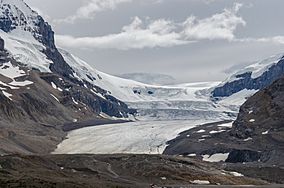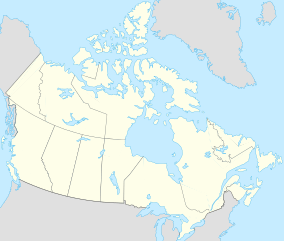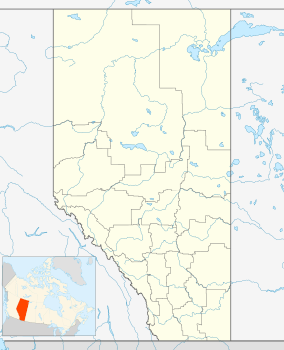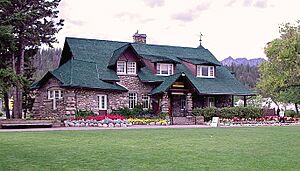Jasper National Park facts for kids
Quick facts for kids Jasper National Park |
|
|---|---|
|
IUCN Category II (National Park)
|
|

Athabasca Glacier in Jasper National Park
|
|
| Location | Alberta, Canada |
| Nearest town | Jasper |
| Area | 10,878 km2 (4,200 sq mi) |
| Established | 14 September 1907 |
| Visitors | 2,415,463 (in 2022–23) |
| Governing body | Parks Canada |
| UNESCO World Heritage Site | |
| Part of | Canadian Rocky Mountain Parks |
| Criteria | Natural: (vii), (viii) |
| Inscription | 1984 (8th Session) |
Jasper National Park is Canada's biggest national park in the Rocky Mountains of Alberta. It covers a huge area of about 11,000 square kilometers (4,200 sq mi). The park was first called 'Jasper Forest Park' in 1907. Later, in 1930, it became a national park. In 1984, it was named a UNESCO World Heritage Site.
You can find Jasper National Park north of Banff National Park. It is also west of the city of Edmonton. The park is famous for its amazing natural features. These include glaciers from the Columbia Icefield, bubbling springs, clear lakes, roaring waterfalls, and tall mountains.
Contents
Park History
First Peoples of Jasper
The land that is now Jasper National Park has been home to many First Nations for a very long time. Groups like the Nakoda, Cree, Secwépemc, and Dane-zaa peoples lived here. Old tools, like Plainview projectile points, have been found near Jasper Lake. These tools are from about 8,000 to 7,000 BCE.
Over many centuries, First Nations used the land in different ways. This changed with the weather and how many animals, like elk and moose, were around. In the late 1700s, Haudenosaunee and Nipissing hunters came to the eastern Rockies. They often worked for the North West Company.
By 1810, hundreds of Haudenosaunee and Anishinaabe people lived in the area. They helped explorers like David Thompson. In 1908, Mary Schäffer Warren was the first non-Indigenous person to visit Maligne Lake. She used a map given to her by Samson Beaver, a Nakoda guide.
Fur Trade and Jasper's Name
Jasper National Park got its name from a fur trader named Jasper Haws. He was from Maryland in the United States. In 1815, Jasper Haws took charge of a trading post. This post was built by the North West Company in 1813 near Brûlé Lake. People started calling it Jasper's House.
In 1830, the trading post moved closer to Jasper Lake. The old site of Jasper House became a national historic site in 1924. Jasper House was taken down in 1910. However, its name lives on in both the national park and the town of Jasper within the park.
How Jasper Park Was Created
Jasper Forest Park was officially started on September 14, 1907. This happened because a new railway was being built across the Rocky Mountains. The park was planned to be a mountain resort. It would have a train station, hotels, and a town for visitors. The idea was to create a "wilderness playground" for people.
However, some Métis families already lived in the park area. They had been there for a long time. In 1909, these families were asked to leave the park. They were paid for their homes and land improvements.
In 1911, the park was renamed Jasper Park. It was managed by the new Dominion Parks Branch. The park had two main goals: to protect nature and to attract tourists. Hunting was not allowed in Jasper Park. This was different from how First Nations had hunted for food for centuries. Even so, wealthy hunters used the park as a base for trips outside its borders.
In 1930, Jasper Forest Park officially became Jasper National Park. This happened when the National Parks Act was passed. This law said that national parks are for "the benefit, education and enjoyment" of Canadians. It also said parks should be kept "unimpaired for the enjoyment of future generations."
Interestingly, the new law also changed the park's boundaries. About 518 square kilometers (200 sq mi) of land were removed from the park. This land, including Brûlé Lake, was then used for coal mining and making electricity.
Early Tourism and Sports
In 1911, the Grand Trunk Pacific (GTP) built train tracks through the park. They also started the town of Fitzhugh, which later became Jasper. Another railway, the Canadian Northern, also built tracks here in 1913. Both railways later joined to form the Canadian National Railway (CNR).
A road was also built between Edmonton and Jasper. The part inside the park was finished in 1928. The rest of the road to Edmonton took three more years.
By 1911, there were eight hotels in Jasper. But they were simple. The fancy Jasper Park Lodge opened in 1922. The CNR used Jasper Park and the lodge in its advertisements.
The town of Jasper became a center for outdoor sports. Companies offered equipment rentals and guided tours for hikers and climbers. The Alpine Club of Canada held many of its camps in Jasper. Even though hunting was not allowed inside the park, outfitters led wealthy hunters on trips just outside the park's boundaries.
Public Works and Internment
In 1916, during World War I, the Canadian government opened an internment camp in Jasper. People from countries Canada was fighting, mainly immigrants from the Austro-Hungarian Empire (including many Ukrainians), were sent there. These men worked on building a road from Jasper to Medicine Lake and Maligne Lake.
During the Great Depression in the 1930s, the government started public works projects. Many workers, including those who lost railway jobs, built roads and bridges in the park. They earned 25 to 30 cents an hour. In 1931, they began building a road between Jasper and Banff. This road later became the Icefields Parkway.
During World War II, internment camps were set up again. About 300 Japanese Canadians were forced to work in three road camps in Jasper. Also, 160 conscientious objectors (people who refused to fight in the war) worked on upgrading roads to Maligne Lake and Medicine Lake. They also built a road to the British Columbia border.
Park Wildlife
Jasper National Park is home to many famous North American animals. There are at least 50 different kinds of mammals living in the park.
Mammals
- American black bear
- American red squirrel
- Beaver
- Bighorn sheep
- Canada lynx
- Caribou
- Coyote
- Elk
- Grizzly bear
- Hoary marmot
- Moose
- Mountain goat
- Mule deer
- North American cougar (mountain lion, puma)
- Porcupine
- Red fox
- River otter
- Snowshoe hare
- Timber wolf
- White-tailed deer
- Wolverine
- Wood bison
Birds
Jasper has many different places for birds to live. At least 160 types of birds have been seen here. Many of them are birds of prey, waterfowl, or songbirds.
- American dipper
- American robin
- Bald eagle
- Black-billed magpie
- Canada goose
- Canada jay
- Common loon
- Common merganser
- Crow
- Golden eagle
- Great horned owl
- Mallard
- Mountain bluebird
- Osprey
- Raven
- Redtailed hawk
- Steller's jay
- Trumpeter swan
Amphibians and Reptiles
You can also find a few types of amphibians and reptiles in Jasper.
UNESCO World Heritage Site
Jasper National Park became a UNESCO World Heritage Site in 1984. It joined other national and provincial parks in the Canadian Rocky Mountain Parks. This was because of its amazing mountain views. These include tall peaks, glaciers, clear lakes, beautiful waterfalls, deep canyons, and limestone caves. Old fossils found here also helped it get this special title.
Park Geography
Water Systems
Most of the water in Jasper National Park flows into the Athabasca River. This river starts in the very south of the park. It begins at a lake that is fed by a glacier from the Columbia Icefield. The famous Athabasca Glacier actually feeds the Sunwapta River, which then flows into the Athabasca River.
Other big rivers in the park that flow into the Athabasca include the Maligne River, the Snake Indian River, and the Miette River. The northern part of the park is drained by the Smoky River. Both the Smoky and Athabasca Rivers are part of the huge Mackenzie River system. This system flows all the way to the Arctic Ocean. The southeast part of the park is drained by the Brazeau River. This river is part of the Saskatchewan/Nelson River system, which flows into Hudson Bay.
Things to Do in Jasper
Easy-to-Reach Attractions
Many popular places in Jasper are easy to get to by road.
- The Mount Edith Cavell hiking area offers beautiful trails.
- Maligne Lake is great for hiking and boating.
- You can explore the deep Maligne Canyon.
- Relax at the Miette Hot Springs.
- Visit the calm Pyramid Lake.
- Take a ride on the Jasper Skytram for amazing views.
- See the Athabasca Glacier, where you can even take a special snow coach tour.
- In winter, the Marmot Basin ski area is a very popular spot.
In summer, people enjoy hiking, fishing, and mountain biking in certain areas. They also love watching wildlife, rafting, kayaking, and camping. Winter activities include Alpine skiing, cross-country skiing, and snowshoeing. Some companies even offer dog sled tours.
Backcountry Adventures
Only a small part of Jasper National Park has roads. The rest is a huge backcountry area. Most of this area can only be reached by trails. Many parts of the backcountry are rarely visited.
You can explore the backcountry by backpacking or riding horses. Sometimes, people use kayaks or rafts. Popular backcountry trips include the Tonquin Valley, the Skyline Trail, and the Fryatt Valley. The remote North Boundary Trail is a long backpacking trip that takes several weeks. You can also canoe or kayak into the backcountry on Maligne Lake.
Park Roads
Jasper National Park has several main roads. These roads are designed to be scenic routes. They help visitors reach all the park's main attractions. Driving these roads is a key part of visiting the park. You can see beautiful scenery and wildlife right from your car.
Highway 16 is the main road through the park. It is part of the Trans-Canada Highway. This road is important for both trade and tourism. It lets visitors see many of the park's sights.
The Icefields Parkway (also called Highway 93) is a 230-kilometer (143 mi) highway. It runs from Lake Louise, Alberta, in Banff National Park, to Jasper, Alberta. This scenic highway follows the continental divide. It offers stunning views of the Canadian Rockies. The parkway has many viewpoints, attractions, hikes, and campgrounds. You can easily reach the Athabasca and Sunwapta Falls from this road. In 2014, the Glacier Sky Walk opened. It is a glass-floored platform 280 meters (919 ft) above the Sunwapta Valley. The Icefields Parkway is only for tourists; no freight trucks are allowed. All visitors must have a park pass.
Maligne Lake Road is a scenic park road that is 44 kilometers (27 mi) long. It goes from Highway 16 near Jasper to Maligne Lake. This road offers great views and access to hiking trails like the Maligne Canyon trails. The speed limit is 60 kilometers per hour (37 mph) because animals often cross the road.
Edith Cavell Road is a 14-kilometer (9 mi) scenic road. It leads to the Edith Cavell meadow area from the Icefields Parkway. This road is open only from May to October. Large RVs are not allowed because of its tight turns.
Miette Hot Springs Road is a 16-kilometer (10 mi) scenic road. It runs from Highway 16 to the Miette Hot Springs, a main attraction.
Alberta Highway 93A is a 24-kilometer (15 mi) road that runs next to the Icefields Parkway. It gives access to hikes, campgrounds, and the Marmot Basin Ski Resort.
Marmot Basin Road leads to the Marmot Basin Ski Area and several hiking trails from Highway 93A.
Celestine Lake Road is a long gravel road along the Athabasca River. It leads to several remote hiking trails.
Pyramid Lake Road is a short road that takes tourists to lakes and resorts just north of Jasper.
Images for kids
-
Mount Athabasca in the park
See also
 In Spanish: Parque nacional Jasper para niños
In Spanish: Parque nacional Jasper para niños
- Dark-sky preserve
- Ecology of the Rocky Mountains
- Jasper Palisade
- List of national parks of Canada
- List of historic places in Alberta's Rockies
- List of trails in Alberta
- List of mountains of Alberta
- List of waterfalls of Alberta
- Wildlife of Canada
- SS Jasper Park









